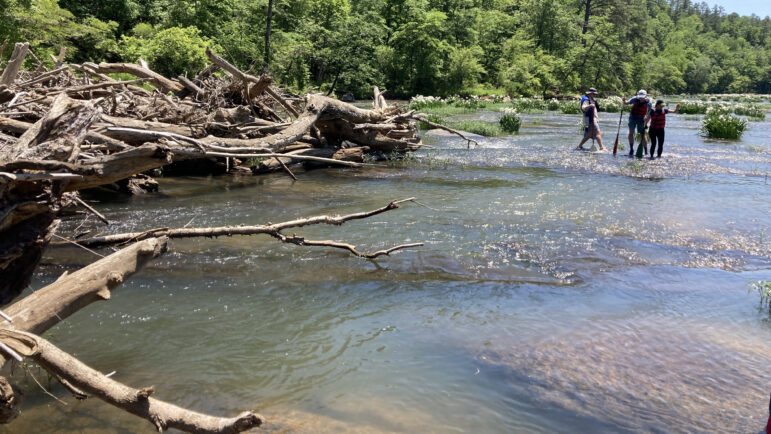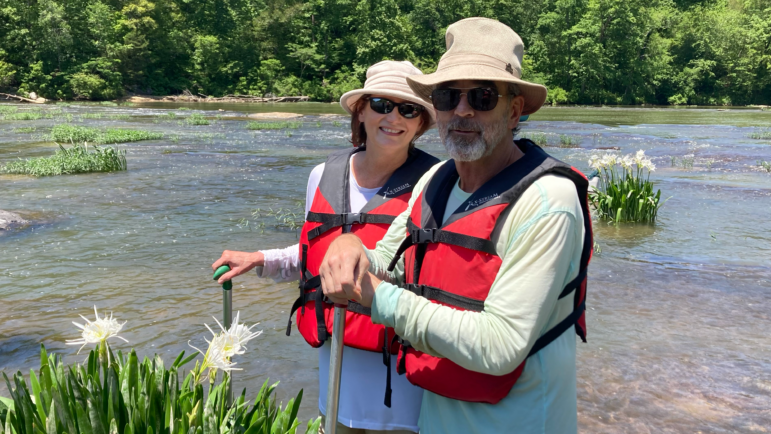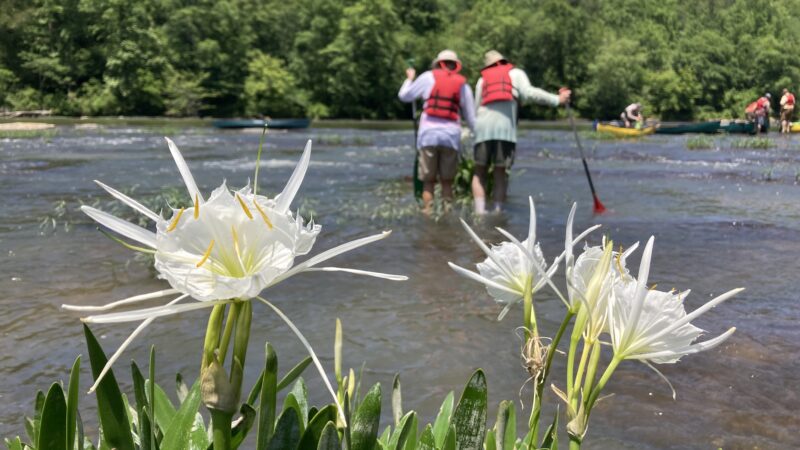Cahaba lily season draws crowds, inspires conservation efforts
This story is part of a monthly series called Outdoor Connections, which features stories that explore the biodiversity of Alabama and how we depend on it.
Lined up along the banks of the Cahaba River in Bibb County, about two dozen people buckle into life jackets and delicately climb into canoes.
“We are about to paddle down through the Cahaba River National Wildlife Refuge to go see the Cahaba lilies, a very, very cool flower that’s pretty geologically remote,” said Wil Rainer, trip leader and field programs director at the Cahaba River Society (CRS).
Cahaba lilies are big white flowers with spider-like petals that bloom for just one day a year, usually between mid-May and mid-June.
The species, which grows in the middle of moving water, is only found in three southern states, and Alabama is thought to be home to one of the largest Cahaba lily populations in the world.
Lily season draws spectators from across the state, hoping to catch a glimpse of the curious flower. For local environmental advocates, it’s a time to celebrate, but it’s also an opportunity to raise awareness of growing threats to the species.

Vulnerable habitat
After a roughly one-mile paddle downstream, the group arrives at Hargrove Shoals, where an expansive field of Cahaba lilies spans the width of the river.
Eager to see the flowers up close, paddlers park their canoes and carefully walk along the smooth rocks lining the shallow water.
Scientist Randy Haddock gathers the group around a clump of lilies in the middle of the river.
“These seem to like this kind of habitat,” Haddock said. “What they’re called is foliated rocks or flat rocks.”
Haddock, who has studied the Cahaba and its biodiversity for decades, said the lily bulbs like to wedge into the rocks along the riverbed and nest there.
It’s a dynamic and vulnerable habitat, evidenced by a menacing pile of dead trees and limbs floating near the flowers.

“Folks, what do you suppose is going to happen with the next high water event, when that thing floats away?” Haddock asked the group. “It’s a good chance it’s going to knock these down or knock ‘em loose.”
Haddock said that’s now a bigger threat than ever before due to activity upstream.
“What’s going on in Birmingham has a lot to do with what happens right here in this kind of special place,” Haddock said.
Erosion upriver
About 50 miles north of Hargrove Shoals, the banks of the Cahaba River look like they’ve been sliced with a knife.
“Sites like this are persistent sediment contributors to the Cahaba River,” said Ben Wegleitner, river sustainability director at CRS.
Over the years, water has eroded large sections of land in this area near Hoover, exposing roughly 20 feet of dirt along the curve.
It’s a persistent problem up and down the river.

These days, Wegleitner said water levels along the Cahaba appear to be more volatile than ever before, with the river rising and falling increasingly fast and to dangerous levels. The problem ties back to stormwater management.
When it rains, people like to quickly move water away and keep it off of roads and out of yards.
“But what that does is speeds up water getting to the Cahaba River, and we’re seeing the erosive effect that has,” Wegleitner said. “It brings trees into the rivers. Collapsing banks will often dislodge trees and send them down river.”
Down river, those trees can plow through clumps of Cahaba lilies, while loose sediment can fill in the precious space between rocks where lily seeds and many other creatures like to nest.
Inspiring change
Seeing the lilies up close, that information hits home for people on the canoe trip, like Sam Foley.
“I didn’t really realize that had a way downstream effect, and it does,” Foley said.
Foley said he’s glad to see more awareness of stormwater management issues and growing efforts to address the problem. More cities are supporting green development, leading to features like retention ponds that help slow runoff from draining into the Cahaba.
Foley said it’s a worthy investment to protect the river and the lilies.
“They’re beautiful,” he said.

For now, the Cahaba lily population appears to be stable, according to river expert Haddock. He said the lily is an incredibly resilient species that people rally around.
“It’s something that has just kind of become a symbol for the Cahaba, and it’s something that has inspired a lot of love and appreciation,” Haddock said.
Haddock credits local scientists who have studied the lilies for decades and discovered much about their habitat and how they grow. But he said at the end of the day, people are drawn to the flowers because they’re big and showy, and they’re a bit mysterious – white lilies growing in the middle of moving water, making an appearance just one day a year.
Learn more about the Cahaba lilies at the Cahaba Lily Festival, Saturday in West Blocton.
Do you have an idea worth featuring as part of our Outdoor Connections series? Email [email protected].
Light from satellites will ruin majority of some space telescope images, study says
Astronomers have long been concerned about reflections from satellites showing up in images taken by telescopes and other scientific instruments.
Defense Department is reviewing boat strike video for possible release, Hegseth says
In a speech on Saturday, Defense Secretary Pete Hegseth defended the strikes, saying: "President Trump can and will take decisive military action as he sees fit to defend our nation's interests."
Bama, Miami in, Notre Dame out and Indiana No. 1 in College Football Playoff rankings
Nobody paying attention for the past 24 months would be surprised to see Indiana – yes, Indiana – leading the way into this year's College Football Playoff.
McLaren’s Lando Norris wins first F1 title at season-ending Abu Dhabi Grand Prix
Red Bull driver and defending champion Max Verstappen won the race with Norris placing third, which allowed Norris to finish two points ahead of Verstappen in the season-long standings.
A ban on feeding pigeons ruffles lots of feathers in Mumbai
The pigeon population has exploded — a result of people feeding the birds. For some it's a holy duty and a way to connect to nature. Critics point to health risks tied to exposure to pigeon droppings.
UN humanitarian chief: world needs to ‘wake up’ and help stop violence in Sudan
The UN's top humanitarian and emergency relief official has told NPR that the lack of attention from world leaders to the war in Sudan is the "billion dollar question".








